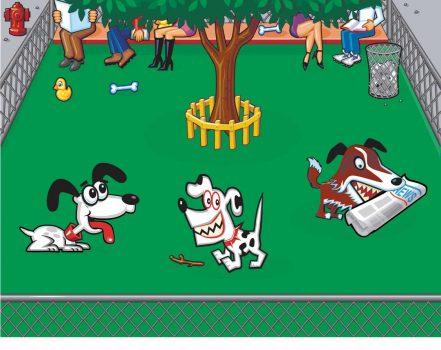Is your puppy ready for the dog park?

Dogs parks can be like little bits of paradise; our pooches can run freely and play with their furry friends. But before just turning him loose, it’s a good idea to get him (and you) dog park ready.
Dog parks can be a great place for your dog to exercise and socialize with other friendly dogs, who can serve as role models and help refine your dog’s social skills. If you both are ready and know how to avoid problems, the dog park should leave you and your canine safe and happy.
First, your dog should be over four months old, current on all vaccinations and in good health. A pup under four months won’t be fully immunized and could be exposed to life-threatening illnesses.
Additionally, if a pup is overwhelmingly frightened at the park during the fear imprint stage (between 8 and 11 weeks) he could be traumatized and will never be comfortable fully socializing with other dogs. So wait until he is ready! Then, make sure dogs are spayed and neutered, and never bring a female in heat.
Before entering a dog park, your dog should know basic obedience commands well, like come and leave it. A good sit and down-stay are handy as well. It is very important to know your dog well, especially how he reacts to other dogs and strangers. Dog parks are meant to be “happy hour” so if your dog is people or dog aggressive, dog parks are not a good option. But a trainer who specializes in treating aggression may give him a chance at a later time.
The best dog park visitor is polite, controls his dog, cleans up after him, anticipates trouble, and removes his dog from situations before anything bad occurs. An ideal visitor also politely asks another dog guardians to stop his dog from irritating his and listens with an open mind if someone complains about his dog.
We, humans, are the ones ultimately responsible for our dog’s behavior. Obey park rules, even if you disagree with them. Control your dog and don’t let him engage in aggressive behavior. That is not only growling or fighting, but can be herding, excessive barking, stalking, slamming, running into people, mounting, crowding, or just playing too rough. Stop interactions before harmful situations occur, and be attentive at all times.
Look for warning signals from the dogs like overall stiffness instead of relaxed bouncy moves, raised hackles, fixations on a particular dog, and chases with nips, growls and escalating speed. If you see a warning signal, call your dog away from the area. Dogs often like to gather at the gate to smell newcomers. Don’t let your dog intimidate newcomers or stay in a crowd for long. Some parks don’t allow treats or toys inside because they can become objects to be battled over. So even if they are allowed, evaluate the situation before bringing them in.
Be aware of the ever-changing dog hierarchy. Dogs are pack animals and are constantly aware of the “energy in the room.” Every time a new dog enters or leaves the park, the dynamics of the pack change. Did a dominant dog just come in? Or an overly rambunctious barker who is creating chaos? Or a small dog resembling a squirrel and is triggering prey drive?
Humans in the dog park not only have to keep eyes on their dog, but on the entire pack to maintain safety and balance. If your dog sees and senses it, then you need to see it too. Notice if an entering dog triggers a negative response from your dog. If your dog sometimes bullies, move to an area away from the others and leave when he exhibits this negative behavior. If he is older or doesn’t like to play, respect his opinion and let him sit and observe. If there is an area for small dogs, and you have a little one, use it. It is for their safety.
Dog parks can be little bits of Heaven on Earth, and with minimal preparation and close observation you and your dog can fit right in.






